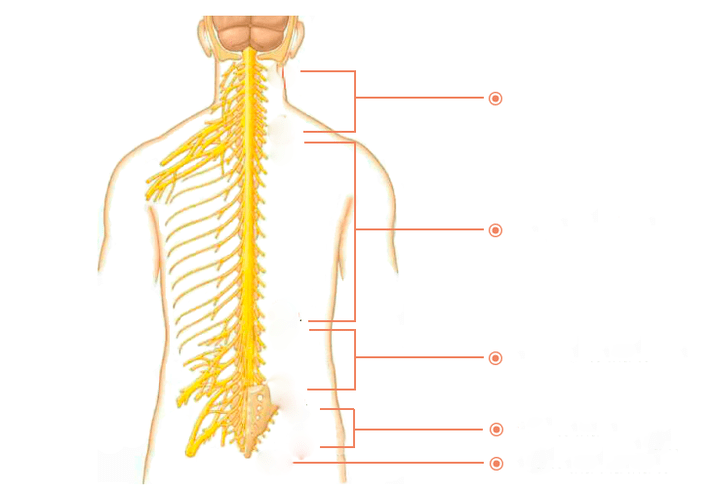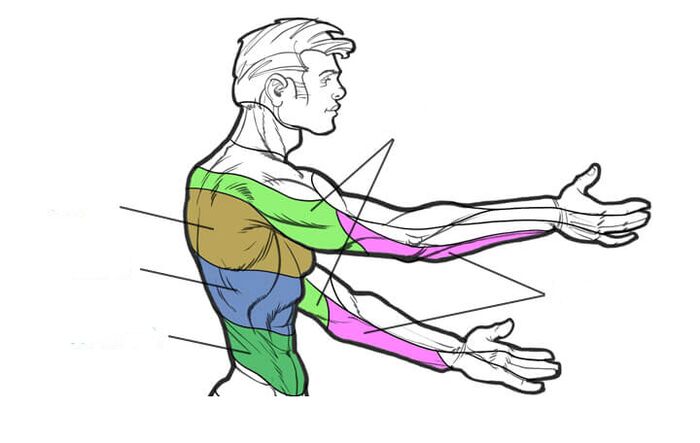The thoracic spine has a peculiarity - it joins the ribs. Because of this it is less mobile than the neck and back. Consequently, osteochondrosis of the chest develops less frequently on the principle of "less mobility - less wear and tear". Symptoms are often confused with angina or myocardial infarction. It is not surprising that they say that thoracic osteochondrosis is a "chameleon". And here one can not make a mistake and miss a heart attack or other serious disease, for example, breast pathology in women. Such mistakes are costly, even if eventually corrected. After all, this can "lead" a person to severe stress. Find a doctor who understands everything and chest osteochondrosisDistinguishes symptoms from other pathologies. Symptoms of osteochondrosis of the chest region are usually divided into two categories - radicular and reflex.
Radical symptoms
They arise due to the impact on the nerves coming out of the spine.
Spinal nerves

A lot of nerves come out of the spine. They are called spinal nerves. Each such nerve is gradually branched out and follows a certain area of the body with clearly defined boundaries. This zone is called the segmental innervation zone. Each spine, disc, nerve, and zone are numbered strictly corresponding to each other. If a nerve is damaged, symptoms will appear in the area of the corresponding segmental innervation of that nerve and not anywhere - in an arbitrary location.
Radical symptoms include:
- Decreased or lost reflexes;
- Sensitivity disorders;
- Muscle weakness;
- Major pain.
Innervation zones of the chest segments
Osteochondrosis D1 – D2- Causes pain in the shoulder, neck and groin.

Osteochondrosis D3 – D6- Causes pain, the nature of the belt in the upper chest. Simulates heart pain, angina attack. In women it causes pain in the mammary glands.
Osteochondrosis D7-D8- Causes belt pain at the level of the solar plexus. Simulates pain in the stomach, liver, gallbladder or pancreas. Reduces upper abdominal reflexes.
Osteochondrosis D9-D10- Causes pain in the hypochondrium and upper abdomen. Sometimes imitates the so-called "acute" abdomen - a sharp pain in the abdomen. Reduces the reflexes of the middle abdomen.
Osteochondrosis D11-D12- Causes pain in the groin area. Simulates pain in women with diseases, appendicitis, intestinal diseases. Reduces lower abdominal reflexes.
Reflex symptoms
Unlike radicular, reflex symptoms have no clear boundaries. These may include difficulty breathing, shortness of breath, pain on inhalation and exhaustion, chills and skin "goosebumps", intercostal neuralgia, and chest pain. Sleep, insomnia and the feeling that you did not get enough sleep. It is difficult to move, especially in the morning. Impaired coordination of movements - this is reflected in walking. General weakness, weakness. In the head. Pain between the shoulder blades. Pain in the hypochondria. Pain when raising the arms. Pain when bending or trying to straighten. Pain between the shoulder blades. In general, pain in osteochondrosis of the chest region can be divided into two types.
Dorsalgia- Moderately prolonged pain with periods of strengthening and weakening in the back and chest.
Dorsago- Severe pain "lumbago" in this area.
- The symptoms of osteochondrosis of the chest region depend on the stage of osteochondrosis.
- They are aggravated by tilting or trying to straighten.
- Symptoms often appear after 35-45 years.
- It is about 3 times more common in women than in men.
You have, of course, noticed that the radicular symptoms are clearly expressed, while the reflex symptoms are very vague and nonspecific. And as you know, anything that does not have clear definitions serves as a convenient cover for professional helplessness. This, among other things, refers to reflex symptoms and such a popular concept of doctors as "age-related changes". Of course, many of you are familiar with the situation when your doctor explained the problem with "reflex" or "age-related" processes. In such moments, most people rightly believe that the doctor simply does not understand what is happening and tries to cover his incompetence in the fog of these "magic words".
Once upon a time there was a popular phrase: "Every accident has a name, a surname and a position". Every disease has its unique symptoms. And it is the duty of the doctor to know them clearly. It is important to find an experienced and knowledgeable doctor, on which both a correct diagnosis and good treatment results will depend.
Diagnosis is the key to proper treatment
There are a number of modern methods of instrumental diagnosis of osteochondrosis today. The most accurate of these are MRI and CT. But the main method is still clinical diagnosis - this is when an experienced doctor compares data from at least three sources - the patient's complaints, MRI results and symptoms. This allows you to make the most accurate diagnosis and create an effective individual treatment program.
Treatment
As you can see, osteochondrosis is a real "tangle" of symptoms, which the doctor will relieve you of pain and suffering. But changes in the spine and discs can not be eliminated. Therefore, the words "treatment of osteochondrosis" must be understood correctly. If you are interested in eliminating pain and other suffering, then yes - it is quite possible. And if you are going to have an academic discussion about returning to the original appearance of the spine and discs, "like a newborn baby", then no, it is impossible to go back in time.
Do not fall for the bait of fraudsters!
It is impossible to return the original appearance of vertebrates and discs!
What is the main method of treatment?
Mild manual therapy is a major type of treatment for osteochondrosis of the chest region. It's like an antibiotic for pneumonia - you can not do without it. Other types - massage, medication, physiotherapy and exercise therapy - are helpful.
How does gentle manual therapy work?
The feeding of the discs is directly related to the muscles surrounding the spine. In addition, the spinal muscles themselves are one of the constituent causes of osteochondrosis pain in the chest region. Mild manual therapy is a special method that allows you to return muscles to their natural physiology, eliminate spasms, muscle cramps, and improve disc nutrition.
The intervertebral discs are the only part of the body that has no blood vessels and is nourished by the proper functioning of the muscles.
In addition to hand treatment chiropractor:
- Remove the load from the affected vertebrae and discs and distribute it correctly;
- Relax the muscles and help them return to normal;
with this:
- Save the patient from clamps;
- Improve disk capacity;
- Restores the motor functions of the body;
- Normalizes blood circulation.
Manual effects mobilize the body's internal forces and self-healing mechanisms.
The treatment is absolutely safe.
Prevention
To prevent relapses, create comfortable conditions for sleep and work. Watch your weight and proper nutrition. Maintain your physical activity. But the main thing is not to forget about health and do not save on it. Do not let things get in the way. After recovery, try to have at least one maintenance session of gentle manual therapy every three to six months - this will reduce the risk factors. Do not forget, neglected osteochondrosis causes complications - protrusion and disc herniation. Remember: Your health is what you need first!
Jogging osteochondrosis causes complications - protrusion and disc herniation.















































